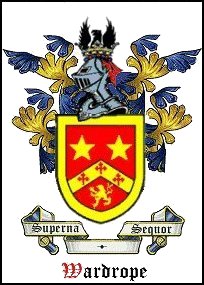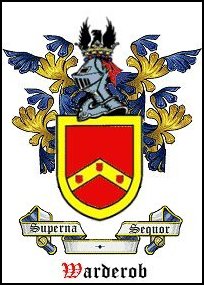
|
|
 |
|||
 |
|
||||||||||
|
|
EXPLANATION OF THE ARMS OF SIR WILLIAM WARDROBE The following information was stimulated by a desire to understand the imagery of the coat of arms attributed to William Wardrobe of Cult, Knight. Sources: "A Dictionary of Heraldry and Related Subjects" by Colonel A.G. Puttock, New York, NY. 1994 "A Dictionary of Haraldry" by Stephen Friar, Harmony Books, NY, NY. 1996 In the 1270's of British History, documentation shows John De Wardrobe in marriage to Mary, daughter of Malcom, and granddaughter of King David of Scotland. The lion of the Coat of Arms for Sir William Wardrobe of Cult is reserved for princes of the realm of Scotland. A Demi-eagle. The term demi means only the upper half of the image is depicted. A demi-eagle is depicted on the Crest Coronet of the arms of Sir William of Cult. The eagle has dominion over all the birds. From the 12th century "Book of Beasts" translated by White, London 1954; a different view of the majestic eagle is found. ' Of all the birds, the eagle alone has seemed to wise men the type of royalty, a bird neither beautiful nor musical nor good for food, but murderous, greedy, hateful to all, the curse of all, and with its great powers of doing harm, only surpassed by is desire to do it." A Crest Coronet. A Crest Coronet is not to be confused with Coronets of Rank, which are ornamental circlets on a coat of arms in place of, or in addition to, the wreath. Crest Coronets are often termed "crowns." The Ancient Crown on the arms of Sir William Wardrobe is of the type called in England, an Eastern Crown and is Scottish in origin. In England it is depicted as a circlet of trefoil-like projections or fleurs-de-lis upon a plain rim. These are generally granted to armigers with antiquarian interests or corporate bodies with royal or ancient associations. The Scottish equivalent has eight tall points [five visible] set on a plain rim. It is Associated with distinguished service in the Near or Far East. The Armorial Helmet. The Armorial helmet used on the arms of Sir William was called an armet. It was used in the late 15th century; which may help establish a time for knighthood. The Crosses. The Crosses found on the arms of Sir William are ones called the Cross-crosslet. A cross-crosslet is a cross that terminates in a cross on each of its three upper limbs. If the cross terminated in a pointed lower limb, it is termed a cross-crosslet fitched or Cross-crosslet fitchy. It generally denotes some service to the church or aid in establishment of a church. A Lion Rampant. The Lion is the principal animal charge in English Heraldry. He may be found in a number of positions. Rampant is a pose, erect with his sinister [left] hind paw on the ground and the dexter [right] hind paw slightly raised forward, the dexter front paw is raised level with the top of his head and his sinister front paw stretched forward slightly below the shoulder. He has a ferocious expression on his face, which is looking to the dexter, with his mouth open and his tongue extended. The Molet. [A Star] The molet or sometimes mullet, generally represents the rowel of a spur. It has five points unless the blazon states otherwise and is frequently pierced. Thus the Molet is associated with horsemanship. Marshalling of Arms. [Descendancy] Marshalling is the art of arranging several coats of arms on one shield generally for the purpose of denoting the alliances of a family. The system is divided into two parts. 1. Temporary and non-hereditary combinations such as the impalement of arms of husband and wife and the impalement of personal arms with those of an office. 2. permanent and hereditary combinations of arms as in the case where a man marries an heiress and his issue who succeed him will inherit the arms of their mother as well as their father. Generally the English System broke up quartered Coats and redistributed them for the sake of simplicity. The Scottish system tended to retain them. It was not necessary for a man to use all of the quarterings to which he was entitled, but he may take a selection from them. If he includes a particular quartering brought in by an heiress, he must include the one which brought it in. Scottish Armorial Practice. The principal function of heraldry was to symbolize the identity of the owner of the armorial bearings. In Scotland, the Clan, the Family and the Name have survived as significant entities in the social organization of Scottish Society. The Lord Lyon King of Arms either in his ministerial capacity or in his judicial capacity determines who is Head of the Clan or Chief of the Family or Name. In Scotland, there is no such thing as a "family coat of arms." Junior members of a family are assigned due and congruent differences and by assigning the scientific and relevant differences to the armorial bearings of younger members of families, Lyon has a vital and continuing influence on family organization in Scotland. Armorial bearings are succeeded to by the heir, and the heir may be the heir male, or female, or an heir nominated within the blood relationship, called the heir of tailzie. According to the Head of the Clan McDuff, Wardrobe [sic] is a sept [division] of the clan McDuff. Scottish Royal Arms. The red lion was probably a device of King William I, [1165-1214] who was known as the Lion. A lion rampant within a bordure of fleurs-de-lis first appears during the reign of his son, Alexander II [1214-1249] and the lion rampant within a double tressure floury counter-flory was first used in the Great Seal of Alexander III in 1251. The lion crest was introduced in the reign of David II [1329-1370], and unicorn supporters were adopted in 1440. For a period between 1471 and 1500 that part of the double tressure above the lion rampant was omitted. The oldest motto "In My Defens' God Us Defens'" was first used by James III ca. 1480. The Scottish arms were quartered with those of England, France and Ireland by James VI, when in 1603, he succeeded to the English throne as James I. To Complete the description. Below is a much earlier Warderob arms which explains the colors chevron, and motto. Our ancestral motto was a wonderful choice. I pray this "motto" for all Waldrop descendants that you too may be blessed by honoring your ancestral parents. |
|
|||||||||
| Arms of Robertus de Warderob, Sir Knight from 1210 A.D. |  |
||||||||||
| Discription of the Arms of Sir Robertus:
"Gules on a chevron argent three escutcheons of the first border or. " The gules or red background symbolizes valor, joy and honor. The chevron symbolizes protection often granted in arms to one as a reward for notable enterprise. The Crest A demi-eagle with wings expanded issuing out of an antique crown. The Motto Superna Sequor ---- [Translation: I follow heavenly things]. In general, the more plain an arms, the older it is. The connection between these two arms seems very clear as there is a remarkable likness considering their owners lived 400 years apart. |
|||||||||||
| Web
Search Multi-Search |
Search
this Website |
||||||||||